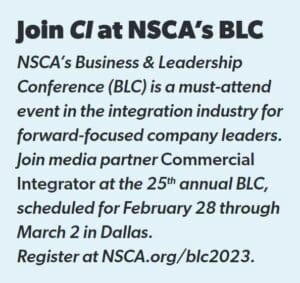At the 2022 Business & Leadership Conference (BLC), Dr. Chris Kuehl reminded us that we’ve seen the end of “just-in-time” product delivery — for a while, anyway. For cashflow-related reasons, we’ve always coached integrators not to sit on excessive inventory. Instead, we argued, you could order products for projects as they were needed, going according to the schedule. This would limit what was just sitting on the shelf.
The supply-chain situation in 2022 has changed all that. Now, NSCA suggests a procurement model based on visibility and probability of your backlog and sales funnel. Business analysts equipped with the proper tools can look at the close rations of projects stuck in the funnel and determine with some level of accuracy which item will most likely be the problem.
‘One Part Missing’
Integrators suffer from a “one-part-missing” bill of materials list on every project. Those missing parts could be a range of things — a key component like a control system, a unique managed switch or, perhaps, something more common, like IP endpoints. When multiplied across dozens of in-house projects, these missing items create big problems. Percentage-of-completion accounting practices for revenue recognition won’t allow you to take that income until you deliver the project and, in many cases, the usage of the system.
At just about every company I visit, inventory levels have doubled — not just because of the backlog and work in progress but also because of the fear of not having critical items when a project is ready for mobilization. Being strategic about this will be key; restocking unused, aged items can be problematic.
You can’t let the manufacturer warranty start or expire with products still sitting on the shelf. Almost every NSCA manufacturer member is willing to adjust warranties if you simply ask. To that point, cultivating a solid relationship with your vendor partners has never been more important.
Financing-Related Concerns
Banks that provide a line of credit for financing view this as a concern, too. Many members see aged inventory being reduced from the traditional 80% to a 50% pledge against the bank’s covenant on the line. The longer that the materials collect dust in your warehouse, the more bankers see the risk of the project being cancelled. You might envision a full warehouse as a signal of a booming business; they, however, see it as risk — and a future ask to increase your line of credit.
 Down payments, progress billings for stored materials, bonded warehouses and daily project-schedule meetings with project managers have become the new normal. Cash is king! Keep interest-rate increases in mind for the rest of this year. The cost of money is projected to rise.
Down payments, progress billings for stored materials, bonded warehouses and daily project-schedule meetings with project managers have become the new normal. Cash is king! Keep interest-rate increases in mind for the rest of this year. The cost of money is projected to rise.
All this has a major impact on labor and scheduling project teams. Utilization in most companies isn’t good. The return-to-project time isn’t accounted for when the system is piecemealed together as parts arrive. The NSCA Labor Installation Standard guidelines are based on the premise that the system is only installed once.
It’s not as easy as it might seem to substitute products. This is a key message for vendor partners, as well. When a specification is written by others, and the submittals and drawings have been approved, you must deliver what was in your contract or start the entire process over again.
Passing Along Unpredictable Costs
Unexpected cost increases must be passed on to clients. Margins aren’t large enough to absorb these unaccounted-for expenses within your cost of doing business. True — it’s easier said than done. But you can’t go broke, either.
Never have we seen such a need to manage “profit killers” as we see today. These profit killers include non-billable surcharges, increased shipping fees, project-schedule delays that cause unplanned overtime, multiple trips, interest charges, re-engineering systems and installing temporary equipment.
For solutions, we turn to NSCA’s Financial Leadership Council (FLC), a group that includes integration company finance leaders that help your trade association understand best practices. A good next step is to read an extended version of this article, including tips from the FLC on how to adjust to this “just-in-case” atmosphere. Visit NSCA.org/nsca-newsletters to read those tips in the Q2/2022 edition of NSCA’s quarterly trade journal, Integrate.




